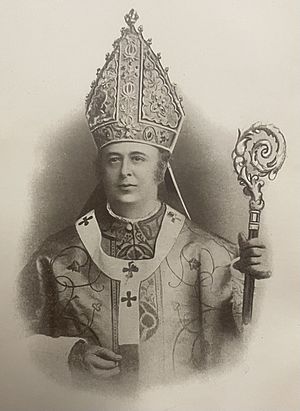Roger Vaughan facts for kids
Quick facts for kids Roger Bede Vaughan |
|
|---|---|
| Archbishop of Sydney | |
 |
|
| Church | Catholic |
| Archdiocese | Sydney |
| Appointed | 5 February 1873 |
| Orders | |
| Ordination | 9 April 1859 |
| Consecration | 19 March 1873 by Henry Edward Manning |
| Personal details | |
| Birth name | Roger William Vaughan |
| Born | 9 January 1834 Herefordshire, England |
| Died | 18 August 1883 Liverpool, England |
| Denomination | Catholic |
| Parents | John Francis Vaughan Elizabeth Louise Rolls |
Roger William Bede Vaughan (born January 9, 1834 – died August 18, 1883) was an English Benedictine monk. He became the second Catholic Archbishop of Sydney in Australia, serving from 1877 to 1883.
Contents
Roger Vaughan's Life Story
Early Years and Education
Roger Vaughan was born in 1834 near Ross-on-Wye, Herefordshire, England. He was one of 14 children in his family. His father, John Francis Vaughan, came from a very old family in England who kept their Catholic faith even when it was difficult. His mother, Elizabeth Louise Rolls, had converted to Catholicism. Many of his brothers and sisters chose to work for the church. One of his brothers, Herbert Vaughan, later became a Cardinal.
When he was six, Roger went to a boarding school for three years. After that, he was taught at home for a while because he wasn't very strong. His home life was very religious. In 1851, he went to Benedictine St Gregory's College at Downside. After his mother passed away in 1853, he decided he wanted to dedicate his life to the church. On September 12, 1853, he joined the Benedictine order and took the religious name Bede.
In 1855, Roger Vaughan went to Rome to continue his studies. He stayed there for four years at a monastery. He was ordained as a priest on April 9, 1859, in a famous church called St. John Lateran.
Becoming a Priest and Teacher
Roger Vaughan returned to Downside in August 1859. In 1861, he became a professor at St. Michael's in Belmont. He taught about deep ideas and how people should live their lives. A year later, he was chosen to be the leader (called a prior) of the local church group and the head of Belmont. He held these important roles for more than ten years.
He also wrote for important magazines and published his most famous book, Life of St Thomas of Aquin, in 1872. In 1865, he met Archbishop Polding from Sydney, Australia. Archbishop Polding asked Vaughan many times to become a special helper bishop (called a coadjutor bishop). On February 5, 1873, Vaughan finally agreed. He was appointed coadjutor of Sydney and given the special title of titular bishop of Nazianzus. Another important church leader, Cardinal Henry Manning, made him a bishop in March of that year in Liverpool.
Helping the Church in Sydney
Vaughan arrived in Sydney, Australia, on December 16, 1873. He immediately started working on two big projects. First, he wanted to make sure Catholic children had good schools. Second, he focused on rebuilding St Mary's Cathedral, which had been damaged by a fire.
From 1874 onwards, Vaughan also served as the head of St John's College at the University of Sydney.
In 1876, he had a disagreement with a group called the Freemasons. He gave a speech where he suggested the Freemasons were trying to undermine religion and take control of the education system.
Leading as Archbishop of Sydney
When Archbishop Polding passed away on March 16, 1877, Roger Vaughan became the Archbishop of Sydney. In 1880, a new law was passed that stopped government money from going to religious schools by the end of 1882. Archbishop Vaughan strongly encouraged Catholics to oppose this law.
He also started plans for a new seminary, a school for training priests, called St. Patrick's Seminary, Manly. Construction for this important building began soon after he passed away.
Archbishop Vaughan faced some challenges from other Catholic leaders and priests in Australia. Many of them were from Ireland and preferred a different style of church leadership. They felt that the Benedictine way, which Vaughan supported, was not as suitable for the mostly Irish Catholic people in Australia.
Vaughan believed strongly in bringing back the idea of monasteries in English-speaking countries like Australia. However, many Irish Catholic leaders had a different vision for the church. This difference in ideas was a big part of Vaughan's time as archbishop. The way the church would develop in Australia was not fully decided until his successor, Cardinal Patrick Francis Moran, took over.
Later Life and Passing
Archbishop Vaughan left Sydney for the last time on April 19, 1883. He planned to go back to Rome. However, he arrived in Liverpool, England, and sadly passed away nearby on August 18, 1883. He was buried in his family's burial place. Later, in 1887, his remains were moved to Belmont. Finally, in August 1946, he was reburied in the crypt of St Mary's Cathedral in Sydney. Vaughan left a large part of his money to the person who would become the next Archbishop of Sydney.

